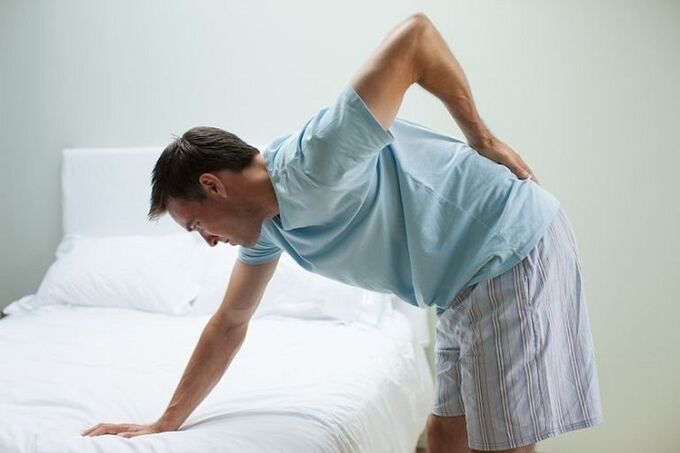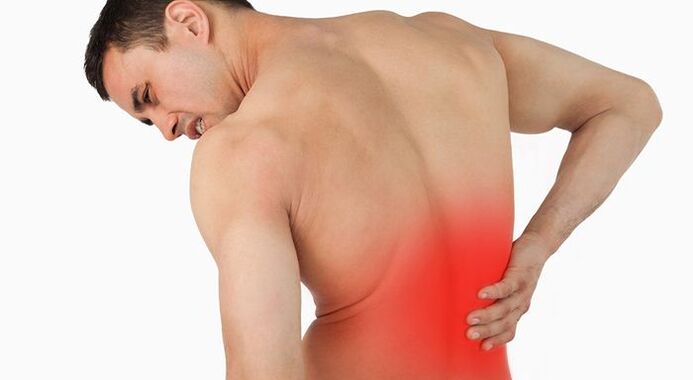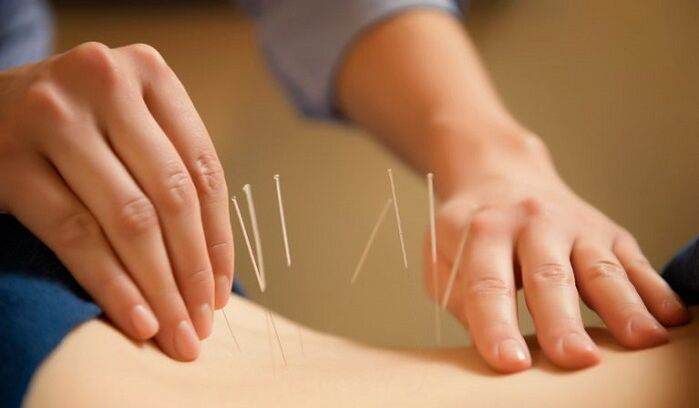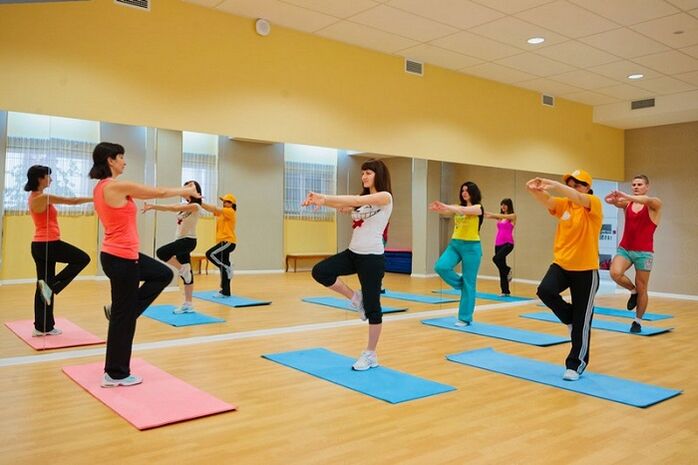
It turns out that back pain in the lumbar area is very common.
According to biologists, such a symptom is a result of our upright posture, in which the load falls mainly on the lumbar region and is not evenly distributed across the spine. Lower back pain can indicate very serious problems not only of the spine, but also of the internal organs.
If the pain is acute and accompanied by a fever, call an ambulance.
If such symptoms are not observed, it is worth consulting a therapist for an accurate diagnosis. Let's see why these symptoms occur, how they can be treated and prevented.
The main causes of lower back pain
First, let's find out the reasons behind these uncomfortable symptoms. Pain can occur primarily in diseases of the spine or secondarily in diseases of the internal organs.
Along with the reasons, it is important to identify the factors that make the pain syndrome worse.

Here you are:
- Features of the profession: heavy physical activity for builders and loaders, and weightlifting for athletes.
- Sitting for longer.
- Obesity and lack of exercise.
- Improper diet and lack of protein, calcium and phosphorus in the body.
- Bad habits: alcohol and alcoholic beverages.
Even as you reduce the effects of these factors, you will noticeably reduce your condition and the health of your spine.
Primary factors
Primary factors are associated with degenerative-dystrophic processes in the spine.
These include:
- Osteochondrosis is a change in the cartilage and intervertebral discs that leads to herniated or deformed discs.
- Spondylosis is characterized by the formation of bony growths on the vertebrae. During this growth, muscle spasms develop around the spine, which limits its mobility. The appearance of injuries in the lower back.
- Spondyloarthrosis is a degeneration of the articular surfaces of the vertebrae, as well as their involvement in the pathological process of ligaments, joints and muscles. In this case, the intervertebral discs are deformed and the mobility of the spine is restricted.
- Spondylolisthesis is expressed by the displacement of the vertebrae, which changes the lumen of the vertebral canal.
- Disc prolapse.
- Radiculopathy is a nerve root injury.
Secondary factors
Secondary occur with accompanying pathologies:
- Metabolic problems.
- Curvature of the spine.
- When there are malignant formations near the spine.
- Infectious diseases: spinal osteomyelitis, tuberculous spondylitis, spinal epidural abscess.
- Spinal injuries.
- Autoimmune diseases.
- Painful symptoms of a psychogenic nature.
- Digestive system diseases.
- Diseases of the pelvic organs.
- Menstrual pain.
Problems with the spine can also be affected by flat feet, ie flattening of the arch of the foot.
Pregnancy can also cause pain. They occur in the early stages when progesterone is exposed to the ligaments and muscles, even if there is a threat of miscarriage or an ectopic pregnancy.
After the birth, pain may occur from stretching the pelvic muscles or, if the spine is subjected to increased stress, by frequently carrying the baby in the arms.
Which diseases signal such pain?
The location of the pain is also important.
So let's look at each case:
- aching pain on the right and above the lower back may indicate pathology of the lungs. These symptoms are accompanied by shortness of breath, cough, and fever. Also about problems with the gallbladder or liver. In this case the pain is sharp;
- if discomfort is felt over the lower back on the left side, it may be a sign of pancreatitis, myocardial infarction, pericarditis, or left-sided pleurisy;
- Symptoms of pain in the lumbar area indicate osteochondrosis in this area, intervertebral hernias and compression fractures;
- A pain symptom below the lower back that radiates into the lower abdomen is a sign of diseases of the pelvic organs. Such diseases include fibroids, endometriosis, prostate pathology, colon disease, and infectious gynecological diseases. It can also indicate that the kidneys are out of order.
Which doctor will help?

Most often, back pain is temporary. Only in rare cases do such symptoms signal complex diseases.
In any case, it is worth knowing which doctor can help in such a situation. With increased physical exertion, severe pain often occurs.
In other cases, you may want to seek help from a surgeon, urologist, or even a chiropractor who will make a more accurate diagnosis and prescribe a similar problem rather than treating it.
In addition, with such pain, you may need to consult a traumatologist, orthopedic surgeon, gastroenterologist, infectious disease specialist, proctologist or gynecologist.
Treatment features
Depending on the causes of back pain, the doctor will prescribe the following therapy options:
- drug treatment with analgesics and hormones;
- blockages, which are injections into the intervertebral joints;
- manual techniques;
- physiotherapeutic procedures;
- Physical therapy;
- Acupuncture.
If conservative treatment doesn't help, surgery is performed.
In the treatment of herniated discs against the background of osteochondrosis, in addition to the main treatment, physiotherapeutic methods are used.
Healing blocks are used when other methods do not have the desired effect. To do this, anesthetics are usually injected into the lumen of the affected joint.
Acupuncture is recommended for bulging discs, osteochondrosis, or hernias. If the pain radiates into the leg, physiotherapy is also used.

Wearing a special corset allows you to limit movement in the lumbar area. This will help relieve pain in the inflammation of the joints.
For back pain, the doctor can give the following recommendations:
- Bed rest on a hard surface for 2-5 days.
- Wearing a special bandage.
- The use of anti-inflammatory and pain reliever drugs.
- To get rid of muscle spasms, muscle relaxants are prescribed. Special drugs are also used to relax the muscles.
- To improve blood circulation and reduce edema, vascular and diuretic drugs are used.
- As a local therapy, all types of gels and ointments are used.
- To consolidate the positive result, physiotherapeutic procedures are prescribed. This can be electrophoresis, phonophoresis, and magnetic therapy.
Physiotherapy and special massages help improve blood circulation, relieve muscle tension and eliminate inflammation.
If the pain in the lumbar region is not related to complex medical conditions, yoga will help alleviate the condition.
You can do these exercises at home and they do not take up much time.
Hypothermia pain
Did you know that hypothermia is a common cause of back pain? In this case, you don't even have to freeze, just sweat and go under the air conditioner.
In this case, the hot body surface comes into contact with a cold air stream. And by the very next day it will be difficult to straighten up or stand up.
In such a situation, the pain becomes constant and aching.
First of all, you need to warm your back. A warming ointment is suitable for this. If there is no remedy, regular alcohol will also help. After rubbing, the lower back should be wrapped in something warm.
A similar procedure is done every day. If there is severe pain, it is worthwhile to see a doctor. Non-steroidal anti-inflammatory drugs are used to relieve pain.
If you are often hypothermic, get a belt made of dog or sheep wool.
What to do with lumbago in the lumbar region?

Such pain occurs with intense physical exertion. When carrying weights, there is a sharp pain that passes into the leg.
A similar symptom is characteristic of lumbosacral radiculitis, which is known as lumbago or lumbago. In such a situation, you need to lie on a hard surface.
Take a pain reliever to relieve pain.
Remember that with signs like this, you cannot take a hot bath or take a steam bath. In this case, dry heat will help more.
For example, a special ointment. It is also worth limiting your salt and fluid intake for several days.
What helps with a hernia?
With a hernia, there is a sharp and constant pain that increases with every movement. Relief comes only in the supine position.
Numbness in the lower back can also be felt. Bed rest and pain medication should be taken to relieve pain. Then you need to call a doctor.
Serious and qualified treatment is required in the acute phase.
What to do about prevention
Do not wait for severe pain to appear, take preventive measures.
Here you are:
- Detection and treatment of comorbidities that can cause lower back pain.
- Proper nutrition with adequate amounts of phosphorus, calcium and other vitamins.
- Heavy physical exertion and heavy lifting should be avoided. In this case, the load should be evenly distributed. Do not make any sudden movements.
- Lead an active lifestyle. Go for a walk, swim, or do yoga.
- Take therapeutic massage classes from time to time.
- If you are seated, take a break every hour and do a little exercise.
- The bed should be comfortable, for example with an orthopedic mattress.
For prevention, you can wear special elastic belts, posture correctors or bandages.
Such devices are recommended during pregnancy and intense physical exertion.
It is important to control your weight as having a large body weight increases the stress on the spine. Get rid of bad habits and get a routine checkup every year.
physical therapy

Exercise at home to strengthen your back muscles and prevent pain. Exercise should be done regularly.
A well-designed set of exercises will help improve posture, increase muscle tone, and also activate blood circulation.
In such a complex, you can use the following movements:
- Body tilts in different directions. First left and right and then back and forth;
- Twists of the body to the sides;
- in the knee - in the elbow position you need to bend your back up and down;
- lying on your back with your legs bent at the knees, your pelvis raised;
- From the prone position, straight legs must be bent at the knees and drawn towards the chest.
Do each exercise 8-10 times.
Do not ignore the symptoms of pain in the lumbar region, see a doctor and take preventive measures that will help normalize your well-being and strengthen your health.














































